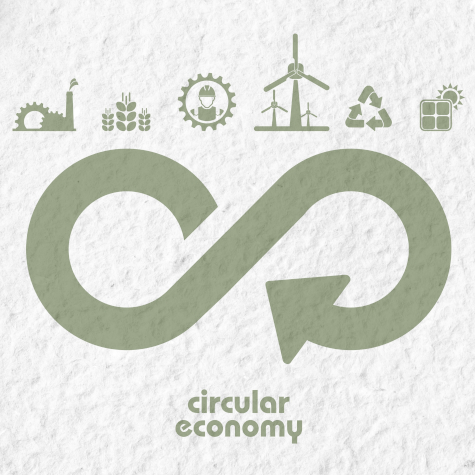
Introduction
In an era defined by environmental consciousness and sustainable practices, the construction industry stands at the intersection of innovation and responsibility. As the built environment continues to expand to meet the demands of a growing global population, so does the imperative to reassess and revolutionise building methods.
In Europe alone, construction makes up more than a third of total energy consumption. And when buildings are demolished, only 40% of construction waste is recycled or reused. Of this 40%, most is downcycled for projects such as road-building, rather than smartly recycled into new buildings.
It is no surprise that construction is at the top of the list when it comes to implementing a circular economy strategy. Rather than adhering to the traditional linear model of “take, make, dispose”, these methods seek to minimise or eliminate waste and pollution by keeping resources in use. This vision not only seeks to mitigate the environmental impact of human activities, but also promises economic resilience in a world grappling with resource scarcity.
As one of the most resource-intensive sectors, the construction industry plays a pivotal role in shaping the sustainability narrative. From material extraction to building construction and eventual demolition, each phase presents an opportunity to embrace circular principles.
Read on to discover how property professionals at all levels can adopt responsible and future-forward construction practices within the circular economy.
Understanding the Circular Economy
The circular economy is a closed system of production in which materials are kept in circulation through processes of maintenance, reuse, refurbishment and recycling. This approach reduces the over-extraction of natural resources and reduce the volume of usable materials in landfills. This series of sustainable practices aims to gradually curb the consumption of finite resources by recycling materials already in circulation.
This model proposes a transformative shift in business practices across industries, with a focus on reducing carbon footprints and adopting sustainable resource management practices from the ground up. From grocery refills to donating clothes to charity shops, we can all think of small ways that we enact circular economy principles in our day-to-day lives, but on an industry-wide level, the circular economy calls for a paradigm shift.
The key principles of a circular economy include preserving and repurposing assets within industries, making collaborative efforts to share materials and products in local areas, designing products with longevity and recycling in mind, and minimising environmental impact and waste. Through the conscientious application of these principles, industries can create more reliable, and resilient products for a sustainable future.
Construction and its Environmental Footprint
It is estimated that by 2060 the combined footprint of buildings constructed weekly around the world will be equivalent to a city the size of Paris. As the built environment grows at an alarming rate, the earth’s resources are becoming critically limited – from mineral resources such as stone and metal, to fuel and water. In fact, the built environment consumes nearly half of all materials extracted globally each year.
On top of this, we must consider the carbon footprint of building projects. On average, building a new home creates one tonne of carbon emission per square metre. This means that an average 100m² newbuild releases the same amount of carbon during its construction as it does over the next 20-50 years of existence. It’s clear that the most impactful contribution to a circular economy lies in the preservation and enhancement of existing buildings, rather than the creation of new ones.
This underscores the urgent need for a reevaluation of our construction practices. By investing in the retention, improvement and repurposing of existing structures, we can reduce the demand for new construction, lowering carbon emissions and mitigating other wasteful impacts. When there is no other option but to build a new structure, consideration must be given to the recycling of materials and the reduction of carbon emissions.
Benefits of Circular Construction
While laying the foundations for a sustainable future is the key concern of the circular economy, its advantages extend well beyond ecological considerations.
For example, using environmentally friendly construction materials and methods in homes and workplaces has a positive impact on physical and mental health, improving the quality of air and light as well as regulating temperature. As a result, productivity has increased in eco-friendly offices and workspaces, with potential gains of up to 10%.
The circular economy also provides a key opportunity to rethink business models and integrate new innovations across the value chain. With new funding being put into material recycling, eco-friendly design and construction, and the renovation of existing structures, a projected additional global market exceeding over 5 billion pounds is anticipated by 2025.
The circular economy model also increases the construction sector’s resilience to supply chain disruptions, such as those caused by natural disasters or political changes. This in turn mitigates the price volatility associated with raw materials. By sourcing recycled materials locally, construction firms can avoid ever-increasing price hikes and invest in stable, low carbon, local employment opportunities.
For investors and construction clients, this translates to an enhanced return on investment, while also working toward meeting governmental carbon emissions targets. By taking a proactive role in promoting the circular economy, property professionals can stand at the forefront of an inevitable and necessary wave of change, building a strategic pathway toward sustained economic growth and social well-being.
Circular Economy Practices in Construction
It’s clear that transitioning to a circular business model opens up a plethora of opportunities for the construction industry, but these benefits are reliant on careful consideration of key factors such as reshaping the supply chain, encouraging collaboration, and promoting decarbonisation.
A holistic reshaping of the supply chain is imperative. Project managers will need to be certain that suppliers at all levels of a project’s lifespan prioritise circular practices over linear approaches. Construction firms need to be willing to invest in careful and ongoing analysis of material and energy flows for each project, so that they can be optimised for ecological impact and efficiency.
Materials passports will play a pivotal role in this context, providing building materials with documented identities and values to keep them visible in the economy. This approach promotes product reuse, assures construction workers of the quality of their repurposed materials, and ultimately reduces waste.
A change in investment strategy will also be key to creating real change in the industry, with crucial make-or-buy decisions weighing initial costs against long-term benefits. Conventional linear practices may seem cheaper, but they result in the loss of fabric utility and value. Embracing models such as product-as-a-service will help investors to see materials as accessible services rather than owned assets.
In order to ensure holistic reform, a truly collaborative ecosystem is needed. Transforming an entire industry requires buy-in at every level, with investors, designers, builders and suppliers coming together to establish an interconnected system with common goals. Embracing innovation and research into digital technology will no doubt become a powerful catalyst for improving the flow and communication between different players in this new circular construction model.
Property professionals need to be ready to make the circular economy work at scale, educating their workforces and advocating publicly for the new model to stakeholders and investors. By establishing clear metrics and goals for reducing waste and carbon output, businesses can report regularly on outcomes and demonstrate the tangible benefits of the circular economy
Finally, it’s critical to align waste-reduction goals closely with decarbonisation targets. The circular economy plays a key role in reducing the construction industry’s carbon output by avoiding the negative impacts of manufacturing new materials. By reusing old products, the need for new manufacturing diminishes, reducing negative carbon, social, and financial effects.
Challenges and Barriers to Circular Economy Practices
Of course, when it comes to fully integrating circular economy practices in a well-established industry, a number of challenges lie ahead.
One significant hurdle is the fragmentation of the industry, leading to a knowledge gap between stakeholders. The design and build approach remains predominantly individualistic, characterised by disconnected work packages and lack of communication.
For example, designers and engineers often find themselves lacking an understanding of the practical considerations of a project compared to contractors, leading to inefficiency and incompatibility between design and delivery teams. This gap is problematic in all construction projects, but bringing a drastic change such as material reuse into play is liable to cause significant communication issues that incur high costs to resolve.
Another obstacle is the construction industry’s adherence to established and mature processes, often grounded in linear “take, make, dispose” thinking. Construction timelines often clash with the procurement of reused materials, leading projects to default to traditional linear routes for secondary materials. The call to rethink a well-established system from the ground up is likely to create resistance.
Likewise, lowest-cost tendering is a prevalent norm in construction, incentivising contractors to prioritise a project’s financial optimisation over material quality or waste reduction. Given that the industry focus has been firmly fixed on cost minimisation for some decades, early dismissal of circular solutions is likely.
Difficulties in the procurement of secondary materials arise as reused materials compete with an established global market of new materials. The ease of procurement and fixed prices associated with new products pose a challenge to the shifting and potentially costly nature of reused materials as the circular economy finds its feet.
Likewise, the limited options and high costs for storage of secondary materials are problematic in an industry characterised by tight construction schedules. This makes is less likely that individual firms will store excess or deconstructed materials for potential reuse.
Methods for Overcoming Barriers
These challenges are by no means insurmountable, but a strategic approach is required to engage stakeholders at all levels of the construction industry and make the circular approach as financially advantageous as it is ecologically.
Encouraging collaboration and skill development across the industry will be a vital first step. Investment in training programs, experiential learning, and fostering a more collaborative approach can lead to better education and a shared vision for a circular economy in the construction sector.
Addressing the knowledge gap and promoting education on circular design principles is a key aspect of this. Sharing best practices and providing education across the supply chain, industry, and government will be instrumental in fostering a circular mindset.
Early engagement is a pivotal strategy for encouraging a collaborative approach. For example, involving demolition contractors in the design process of a project can help project managers to address materials-related challenges at an earlier stage, fostering a more collaborative, effective and waste-reducing approach from the ground up.
Developing a set of commonly shared metrics and indicators to measure circularity consistently is fundamental. These metrics not only provide comparable insights on the status quo of circularity but also allow for meaningful progress measurement.
Material passports are a practical solution to this. These documents provide data on reused construction materials, providing proof of provenance, and enabling traceability across their lifespans. This not only enhances the visibility of materials, but also acts as an enabler for potential reuse.
Practically speaking, deconstructable architecture presents a paradigm shift, enabling easier and low-carbon salvage of materials during deconstruction, and facilitating their onward reuse.
The establishment of local materials reuse hubs serves as a tangible response to the limitations on transporting and secondary materials, providing affordable storage and promoting collaborative reuse and remanufacturing.
And because a new ecosystem needs funding and incentivisation to thrive, advocating for adjustments in the tax system is a crucial step in overcoming financial barriers to change. A system that encourages resource-efficient decisions by taxing virgin materials higher than secondary ones may act as a powerful financial lever.
Conclusion
We are rapidly approaching a point where the circular economy is not a choice but a necessity, especially given its alignment with the global commitment to eliminate carbon emissions. Careful maintenance, smart repurposing and eco-friendly refurbishment of existing buildings to offers a tangible way to break the boom-and-bust cycles of new construction, while material reuse drastically reduces the environmental harm caused by necessary new buildings.
If the construction sector fully embraces a circular economy approach, the potential for transformative change is substantial. Environmental benefits include a projected 38% reduction in global CO2 emissions from building materials by 2050. Beyond environmental concerns, this transition fosters public health and community well-being, enhances the sector’s resilience to supply chain disruption, and introduces new jobs and investment opportunities.
In order to achieve these aims, we need to holistically rethink our approach to designing the built environment by integrating cutting-edge technologies and adopting innovative business models. Professionals at every level of the property business from investors to surveyors to construction workers need to collaborate to create a new ecosystem, where skills are shared, material documentation is standardised, and standards are rigorously met.

